![]()
![]()
![]()
Use LEFT and RIGHT arrow keys to navigate between flashcards;
Use UP and DOWN arrow keys to flip the card;
H to show hint;
A reads text to speech;
106 Cards in this Set
- Front
- Back
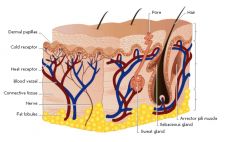
locate dermis, epidermis and subcutaneous layer
|

|
|
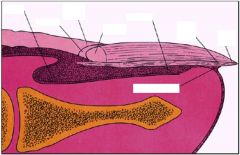
nail structure: identify nail bed, nail plate, proximal fold, lateral fold, free edge, lunula
|

|
|
|
fx of skin
|
protective barrier, keeping outside contaminants out and also keeping homeostasis within (i.e. preventing against water loss)
|
|
|
fx of hair
|
protection and insulation, also perform sensory function
|
|
|
fx of nails
|
protect the distal ends of the fingers and toes
|
|
|
list in order the steps for performing an exam of skin, hair and nails
|
1) visually inspect and palpate hair
2) separate hair with q tip to inspect scalp 3) inspect skin of face and neck, upper chest and expremities 4) inspect skin of hands, inspect nail beds and nail plates and capillary refill 5) inspect skin of upper back 6) have pt lie down, inspect skin of lower chest, abdomen, and lower extremities 7) inspect skin of feet and toenails 8) have patient roll onto their side and inspect skin on lower back, gluteal and perianal area, and backs of lower extremities 9) if indicated perform inspection with woods lamp |
|
|
purpose of visually inspecting and palpating the hair
|
hair texture can change with certain diseases and different diseases can show different patterns of hair loss
|
|
|
purpose for separating hair with q tip to inspect scalp:
|
skin lesions can be hidden by hair and without this inspection could go unnoticed
|
|
|
purpose for separating hair with q tip to inspect scalp:
|
skin lesions can be hidden by hair and without this inspection could go unnoticed
|
|
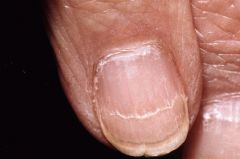
|
beau's nails
|
|
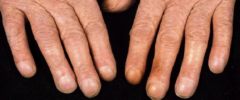
|
clubbing
|
|
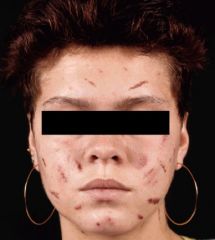
|
excoriation
|
|
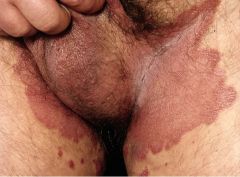
|
fissure
|
|
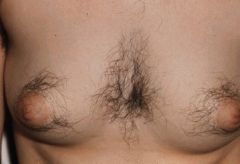
|
hirsutism: increased hair growth in a male pattern from increased androgen activity in a female
|
|

|
Koilonychias- [spoon nails] thinning of nail plate seen in anemia
|
|
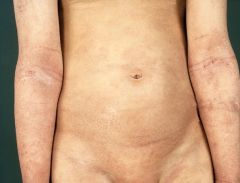
|
Lichenification; thickened exaggerations of the skin folds
|
|

|
Macule: flat lesion, <1cm in size
|
|
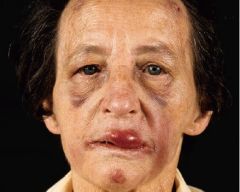
|
nodule: solid raised lesion that is deeper and firmer than a papule; 0.5 to 2cm in size
|
|

|
Papule: solid, raised lesion, <0.5cm in size
|
|
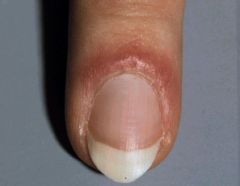
|
Paronychia: inflammation of the tissues adjacent to the nail of a finger or toe usually accompanied by infection and pus formation
|
|
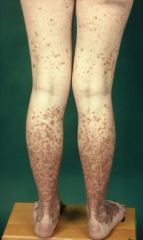
|
purpura: extravasion of blood into the skin from the vessels
|
|
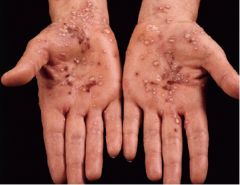
|
Pustule: lesion filled with white pus
|
|
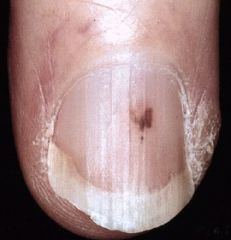
|
splinter hemorrhage
|
|
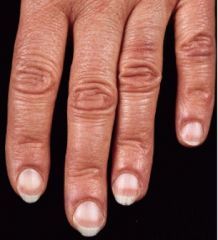
|
terry's nails: The condition is thought to be due to a decrease in vascularity and an increase in connective tissue within the nail bed.[3] It frequently occurs in the setting of hepatic failure, cirrhosis, diabetes mellitus, congestive heart failure, hyperthyroidism, and/or malnutrition.
|
|
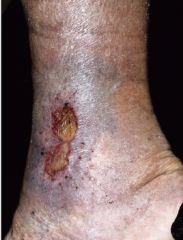
|
Ulcer: deeper loss of of all skin layers and deeper tissue
|
|
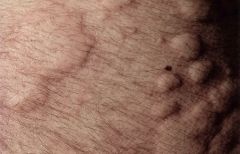
|
urticaria, hives (wheal)
|
|
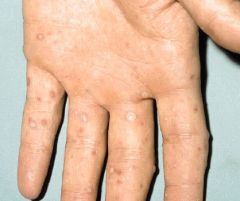
|
HFM disease/ Vesicle: filled with clear, serous fluid, <0.5 cm in size
|
|
|
reason to inspect skin of face and neck, upper chest and expremities
|
check for changes in coloration or lesions, moisture, temp, texture, mobility and turgor
|
|
|
reason to inspect skin of hands, inspect nail beds and nail plates and capillary refill:
|
check for turgor on hands, discoloration or indentations in nails can be signs of systemic disease, poor capillary refill can indicate vascular problems
|
|
|
reason to inspect skin of upper back
|
check for changes in coloration or lesions, moisture, temp, texture, mobility and turgor
|
|
|
reason to inspect skin of lower chest, abdoment and lower extremities
|
check for changes in coloration or lesions, moisture, temp, texture, mobility and turgor
|
|
|
reason to inspect skin of feet and toenails
|
discolorations or indentations in nails can be signs of systemic disease
|
|
|
reason to inspect skin on lower back, gluteal and perianal area, and backs of lower extremities
|
check for changes in coloration or lesions, moisture, temp, texture, mobility and turgor
|
|
|
reason to inspect with a wood's lamp
|
wood’s lamp can cause skin color to change indicating areas of different disease (bacterial, fungal, etc)
|
|
|
actinic
|
: of, relating to, resulting from, or exhibiting chemical changes produced by radiant energy especially in the visible and ultraviolet parts of the spectrum
|
|
|
alopecia
|
loss of hair; the extreme can be loss of hair on scalp, eyebrows, eyelashes, beard, and body. More common is male pattern hair loss.
|
|
|
annular
|
forming a ring
|
|
|
apocrine
|
secreting
|
|
|
beau's lines
|
horizontal lines that grow out with the nail. They mark a stressful event such a high fever or severe illness
|
|
|
bulla
|
filled with clear, serous fluid, >0.5 in size
|
|
|
cherry angioma
|
bright or ruby red, 1-3mm in size, round, may show partial blanching with pressure
|
|
|
clubbing
|
raised proximal nail folds that are spongy in consistency. Either congenital or a sign of COPD, heart disease or GI disease
|
|
|
comedone
|
blackhead
|
|
|
confluent
|
flowing or coming together, i.e. confluent lesions
|
|
|
crust
|
dry layer of serum, pus, or blood
|
|
|
cyanosis
|
bluish or purplish discoloration due to deficient oxygenation of the blood
|
|
|
cyst
|
firm mass, deep, >1cm
|
|
|
dermatographia
|
condition in which lightly scratching your skin causes raised, red lines where you've scratched. Also called Excoriations
|
|
|
dermis
|
middle skin layer that contains connective tissue, sebaceous glands, sweat glands and hair follicles. Nourishes the epidermis.
|
|
|
desquamation
|
to peel off in the form of scales : scale off
|
|
|
ecchymosis
|
large areas of extravasion of blood into the skin from the vessels.
|
|
|
eccrine
|
of, relating to, having, or being eccrine glands
|
|
|
eczema
|
an inflammatory condition of the skin characterized by redness, itching, and oozing vesicular lesions which become scaly, crusted, or hardened
|
|
|
epidermis
|
most superficial layer of the skin that is thin and devoid of blood vessels. Consists of outer dead keratinized cell layer and inner cellular layer where melanin and keratin are formed
|
|
|
erosion
|
superficial loss of epidermis
|
|
|
excoriation
|
welts caused by scratching
|
|
|
fissure
|
a break or slit in tissue usually at the junction of skin and mucous membrane
|
|
|
hirsutism
|
increased hair growth in a male pattern from increased androgen activity in a female
|
|
|
hyperkeratosis
|
hypertrophy of the stratum corneum layer of the skin
|
|
|
ichthyosis
|
any of several diseases usually of hereditary origin characterized by rough, thick, and scaly skin—called also fishskin disease
|
|
|
induration
|
1 : an increase in the fibrous elements in tissue commonly associated with inflammation and marked by loss of elasticity and pliability 2 : a hardened mass or formation
|
|
|
intertrigo
|
inflammation produced by chafing of adjacent areas of skin
|
|
|
jaundice
|
yellowing caused by increased bilirubin levels
|
|
|
keratin
|
protein that provides structural basis of outer layer of skin, hair and nails
|
|
|
keratosis
|
a disease of the skin marked by overgrowth of horny tissue
|
|
|
koilonychias
|
[spoon nails] thinning of nail plate seen in anemia
|
|
|
lichenification
|
thickened exaggerations of the skin folds
|
|
|
lentigines
|
a small melanotic spot in the skin in which the formation of pigment is unrelated to exposure to sunlight and which is potentially malignant
|
|
|
lunula
|
whitish moon at proximal end of nail plate
|
|
|
maculae
|
flat lesion, <1cm in size
|
|
|
melanin
|
any of various black, dark brown, reddish brown, or yellow pigments, gives skin it’s color
|
|
|
nail bed
|
rich vascular structure for adherence of the nail
|
|
|
nail plate
|
hard translucent portion of nail, composed of keratin
|
|
|
nail root
|
area of nail plate covered by proximal nail fold
|
|
|
nevus
|
a congenital or acquired usually highly pigmented area on the skin that is either flat or raised
|
|
|
nodule
|
solid raised lesion that is deeper and firmer than a papule; 0.5 to 2cm in size
|
|
|
onycholysis
|
lifting up of the nail. Can be seen in hyperthyroidism [ring finger is affected] or in onychomycosis, trauma, chemical exposure, or psoriasis.
|
|
|
papule
|
solid, raised lesion, <0.5cm in size
|
|
|
paronychia
|
inflammation of the tissues adjacent to the nail of a finger or toe usually accompanied by infection and pus formation
|
|
|
petechia(e)
|
a minute reddish or purplish spot containing blood that appears in skin or mucous membrane as a result of localized hemorrhage
|
|
|
plaque
|
solid, slightly raised lesion, >0.5 cm in size, often a confluence of papules
|
|
|
pruritus
|
localized or generalized itching due to irritation of sensory nerve endings
|
|
|
plaque
|
solid, slightly raised lesion, >0.5 cm in size, often a confluence of papules
|
|
|
pruritus
|
localized or generalized itching due to irritation of sensory nerve endings
|
|
|
purpura
|
extravasion of blood into the skin from the vessels.
|
|
|
pustule
|
lesion filled with white pus
|
|
|
scale
|
thin flakes of epidermis
|
|
|
sebaceous
|
secreting sebum (fatty substance)
|
|
|
seborrhea
|
abnormally increased secretion and discharge of sebum producing an oily appearance of the skin and the formation of greasy scales
|
|
|
serpiginous
|
slowly spreading
|
|
|
splinter
|
a thin piece (as of wood) split or broken off lengthwise ; especially : such a piece embedded in the skin
|
|
|
subcutaneous
|
being, living, used, or made under the skin
|
|
|
telangiectasia
|
an abnormal dilation of red, blue, or purple superficial capillaries, arterioles, or venules typically located just below the skin's surface (as on the face)
|
|
|
tumor
|
solid lesion, >2 cm in size
|
|
|
turgor
|
the normal state of turgidity and tension in living cells- test this by pulling up skin on posterior hand and see how quickly it goes back to it’s original state
|
|
|
tzanck test
|
is scraping of an ulcer base to look for Tzanck cells
|
|
|
ulcer
|
deeper loss of of all skin layers and deeper tissue
|
|
|
urticaria
|
hives
|
|
|
varicella
|
chicken pox
|
|
|
vellus
|
short, fine, inconspicuous hair that is relatively un-pigmented
|
|
|
vesicle
|
filled with clear, serous fluid, <0.5 cm in size
|
|
|
wheal
|
slightly raised, transient skin edema, varies in size and shape
|
|
|
zosteriform
|
resembling shingles
|
|
|
identify expected age and condition variations in the skin, hair, and nails
|
o skin loses elasticity with age
o hair becomes thinner with age, some loss o nails become more brittle with age |
|
|
psychomotor objectives for SHN
|
• obtain medical, behavioral, psychosocial, and family history data relevant to the presenting problem with skin, hair, or nails;
• select appropriate equipment for conducting an assessment of the skin, hair, and nails; • perform a thorough examination of the skin, hair, and nails; • record accurately and concisely the physical exam findings for an examination of the skin, hair, and nails; |
|
|
affective objectives for SHN
|
• demonstrate sensitivity to the patient with a skin condition, by maintaining professional demeanor and using appropriate measures to ensure patient privacy.
|

